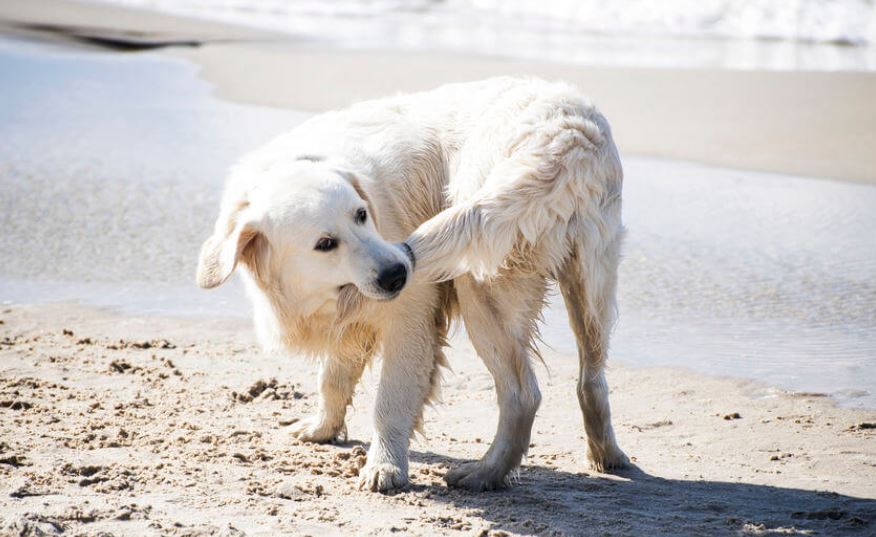+91 8073387610

Why dogs chase thier tail? Has this question crossed your mind?
Dogs chasing their tails can be an amusing sight, but it can also be a sign of various underlying reasons or behaviors.
Why dogs chase thier tail? Top 10 reasons !
Here are ten possible explanations for why dogs chase their tails, along with detailed descriptions for each reason:
- Playful Behavior: Dogs often chase their tails as a form of play. They may see their tail as a moving object and instinctively try to catch it, just like they would chase a toy or a ball.
- Boredom or Excess Energy: Dogs that lack mental or physical stimulation may resort to tail chasing as a way to entertain themselves. This behavior is more commonly observed in breeds with high energy levels, such as Border Collies or Australian Shepherds.
- Attention-Seeking: Tail chasing can be a dog’s attempt to get attention from their owners. If the dog receives a positive response, such as laughter or attempts to interact, they may continue the behavior as a means of seeking attention and engagement.
- Anxiety or Stress: Dogs experiencing anxiety or stress may chase their tails as a self-soothing behavior. It can be a coping mechanism, much like humans biting their nails or tapping their feet when nervous.
- Compulsive Disorder: Tail chasing can be a symptom of a compulsive disorder in dogs, similar to obsessive-compulsive disorder (OCD) in humans. Dogs with this condition may have repetitive, ritualistic behaviors, and tail chasing becomes a compulsive action that is difficult for them to control.
- Fleas or Skin Irritation: If a dog has fleas or other skin irritations, they may chase their tail in an attempt to alleviate the itching or discomfort caused by these pests. This behavior is often accompanied by other signs of itchiness, such as scratching or biting at the tail or hindquarters.
- Lack of Socialization: Dogs that haven’t been adequately socialized with other dogs or animals may chase their tails as a result of not understanding their own body and tail movements. This behavior is more common in puppies who are still learning about their surroundings and the concept of personal space.
- Tail Injuries or Pain: Dogs with tail injuries or pain may chase their tails as a response to discomfort. It could be an attempt to inspect the injured area or relieve the pain, similar to how humans may touch or rub a sore spot.
- Prey Drive: Some dogs have a strong prey drive, and tail chasing can be an instinctive response to the movement of their own tail. They perceive it as something to be chased and caught, much like they would if they were hunting prey.
- Genetic Predisposition: In certain breeds, tail chasing may have a genetic component. For example, certain terrier breeds were historically bred for chasing small prey, so their inclination to chase moving objects, including their own tail, may be more pronounced.
It’s important to note that tail chasing, particularly when excessive or accompanied by other concerning behaviors, may require attention from a veterinarian or a professional dog behaviorist.
They can provide a proper diagnosis and offer appropriate guidance or treatment for the underlying cause.
Should I be worried?
If your dog is occasionally chasing their tail as part of normal play behavior, there is usually no cause for concern.
However, if the tail chasing becomes excessive, compulsive, or is accompanied by other worrisome behaviors, it may be a reason to seek veterinary advice. Here are some signs that might indicate a cause for worry:
- Excessive and Persistent Chasing: If your dog is constantly chasing their tail to the point where it interferes with their normal activities or becomes an obsessive behavior, it could indicate an underlying issue.
- Self-Injury: If your dog is biting, chewing, or injuring their tail during the chasing behavior, it can lead to physical harm such as skin irritation, bleeding, or infections.
- Changes in Appetite or Weight Loss: If tail chasing is accompanied by a loss of appetite or weight loss, it could indicate an underlying medical condition or anxiety.
- Aggressive Behavior: Tail chasing accompanied by aggressive behavior towards oneself or others is a cause for concern and should be addressed promptly.
- Excessive Grooming or Itching: If your dog is excessively grooming or scratching their tail, it could indicate fleas, allergies, or other skin conditions that require veterinary attention.
- Changes in Mood or Energy Levels: If your dog’s mood or energy levels have significantly changed alongside tail chasing, it may be an indicator of an underlying health issue or emotional distress.
- Persistent Anxiety or Stress: If your dog appears anxious or stressed while chasing their tail, it could be a sign of an ongoing problem that needs to be addressed with the help of a professional.
Remember, every dog is unique, and some may have occasional bouts of tail chasing without any significant underlying issues.
However, if you observe any of the above signs or if you are concerned about your dog’s behavior, it is always best to consult with a veterinarian or a professional dog behaviorist who can assess the situation and provide appropriate guidance and treatment if necessary.






